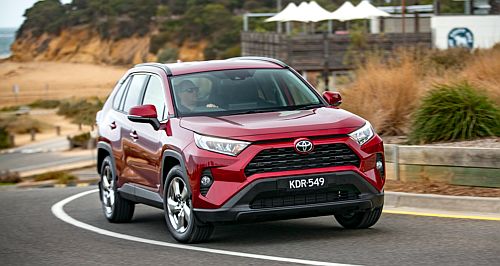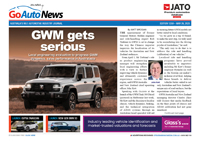News - VFACTS - Sales 2024Toyota RAV4 tops record 2024 new sales tallyRecord sales bolster confidence in the new car market, with 1,220,607 units sold across 20247 Jan 2025 By MATT BROGAN A RECORD number of new vehicles have been sold across Australia in 2024, defying expectations and countering cost-of-living concerns many predicted would severely impact year-on-year registrations.
Led by the strong-selling Toyota RAV4 (with 58,718 unit sales), some 1,220,607 new vehicles took to Australian roads in 2024, an increase of 3827 units on last year’s “unprecedented milestone”.
And while the FCAI was quick to caution that the threat of tougher times lies ahead, the statistics show a level of resilience across a variety of segments, with some experiencing all-time highs, and others new lows.
On your marque…
Toyota continued its dominance over the Australian new car market in 2024, selling an impressive 241,296 units – or 12.1 per cent more than the same time last year. The figure sees the Big T take a 19.8 per cent share of the market overall, a significant 2.1 per cent gain over 2023.
Second place Ford – the only other marque to end the year with a six-figure sales tally – amassed 100,170 unit sales, or 14.1 per cent more than in 2023. The Blue Oval currently holds 8.2 market share points in the Australian market, a full percentage point higher than it did last January.
In third place, we find Mazda with 95,987 unit sales to December 31, a decline of 4.0 per cent. The Japanese importer holds 7.9 market share points, down 0.3 per cent from its position at the end of 2023.
Fourth place went to Kia with 81,787 unit sales (and 6.7 market share points), up 7.4 per cent, ahead of fifth place Mitsubishi with 74,547 unit sales (and 6.1 market share points, up 17.4 per cent. Sixth place was awarded to Hyundai with 71,664 new vehicle registrations, 5.9 market share points, and a 4.7 per cent loss against last year’s volume.
In seventh place we find MG down 13.3 per cent on its 2023 total with 50,592 unit sales and a 4.1 per cent share of the overall market. The Chinese importer was followed by Isuzu Ute with sales of 48,172 units (and 3.9 market share points), an increase of 6.2 per cent.
Rounding out the top 10 we find Nissan in ninth place with 45,284 unit sales (3.7 market share points and an increase of 15.0 per cent) and GWM in tenth position with 42,782 units sales (3.5 market share points and an increase of 17.5 per cent).
Speaking on the success of GWM in Australia, brand head of marketing and communications Steve Maciver said, “Our growth in Australia highlights the commitment we’ve made to this market … expanding our dealer network and achieving record sales through the introduction of multiple new products underscores the brand’s dedication to understanding and exceeding the expectations of Australian drivers”.
“GWM’s success in Australia, showcases the importance of listening to customer needs and investing in long-term relationships. With continued innovation and customer-first service, GWM is set to achieve even greater milestones in the years ahead,” he concluded.
Petrol and diesel stay the course
While it is fair to say that New Energy Vehicles are making their mark, it is equally evident that petrol- and diesel-powered models continue to form the lion’s share of all new vehicles sold.
For 2024, some 528,978 petrol-powered cars and SUVs were sold across Australia, a fall of 10.1 per cent on the year prior.
Though slightly down, the number indicates petrol remains the fuel of choice for the majority, with 43.3 per cent of new vehicle sales powered by petrol alone – or 57.5 per cent when including petrol-electric hybrid vehicles.
Diesel sales tallied 369,842 units over the 12 months to December 31, down just 2.5 per cent on the previous calendar year and formed primarily from the sale of light commercial vehicles (of which 270,351 units were sold).
How the New Vehicle Efficiency Standard (NVES) impacts the share of petrol- and diesel-powered models sold will be of great interest to many in the market, particularly those brands reliant solely on traditional motive power.
New energy vehicles see mixed success
VFACTS figures show hybrid electric vehicle (HEV) sales rose to 172,696 (up 76.0 per cent) across 2024, while battery electric vehicle (BEV) sales finished the year with 74,612 unit sales (down 14.5 per cent), and plug-in hybrid electric vehicles (PHEV) 23,163 (up 100.2 per cent).
Toyota – whose passenger vehicle range has been all-hybrid since June 5 – led the petrol-electric field with an impressive 118,081 hybrid units sold across the calendar year – an increase of 45,997 units on the year prior (up 63.8 per cent).
Equally impressive was the achievement of luxury importer Lexus which sold 10,164 electrified units sold across 2024, or 74.5 per cent of its total unit sales.
“From a disruptor brand with a niche lineup, we have evolved into a fully established luxury lifestyle brand with an extensive portfolio of vehicles that includes BEVs, PHEV and hybrids,” said Lexus Australia chief executive John Pappas.
“Our line-up reflects our determination to adopt a multi-pathway approach on our journey towards electrification, ensuring that no customers are left behind.
BEV sales, which were originally have tipped to have increased in 2024, fell somewhat against HEV and PHEV alternatives.
The Electric Vehicle Council (EVC) says data from its own and public sources indicate 114,000 new BEVs and PHEVs were sold in Australia in 2024, up on the previous record of more than 98,000 sales in 2023.
It says new EV sales in 2024 include approximately 91,000 BEVs and about 23,000 PHEVs.
“Electric vehicle uptake in Australia has reached an all-time high, with about 114,000 EVs sold in 2024, setting a new annual sales record for the country,” said EVC head of policy, legal, and advocacy Aman Gaur.
“Last year's steady increase in EV sales and market share builds on a bumper 2023. Year after year, electric vehicle sales in Australia continue to climb, proving that demand for cleaner, more affordable driving is here and it’s rising.
Passenger car sales slide
Segmentation data shows passenger car sales have retreated by 3.8 per cent year-on-year to total 203,384 units across 2024.
The number places passenger car sales below those of light commercial vehicles (270,351) and SUVs (695,566), and above heavy commercial vehicle sales (51,306).
The majority of passenger vehicle sales come from the Small segment where the likes of the Toyota Corolla (up 20.2 per cent to 24,027 units) and Kia Cerato (up 167.5 per cent to 15,502 units) drove sales to 92,964 for the calendar year, and improvement of 10.2 per cent on 2023.
Medium segment sales tallied 46,146 for the 2023 calendar year, down 4.3 per cent, and led by the likes of the Toyota Camry (up 45.6 per cent to 15,401 units) and BYD Seal (a new entrant with 6393 unit sales).
The passenger car market’s third place was held by the Light segment with 31,189 unit sales, a slide of 19.3 per cent on the previous year. Light segment toppers include the MG 3 (down 18.6 per cent to 12,563 units) and Suzuki Swift (down 11.4 per cent to 6126 units).
Passenger market sales were dominated by private buyers (116,721 down 8.3 per cent) ahead of business buyers (63,900 up 1.5 per cent), rental fleet buyers (17,960 up 9.7 per cent), and government fleet buyers (4803 up 1.0 per cent).
SUV sales gain ground
It comes as no surprise that SUV sales dominated the market again in 2024, the high-riding category totalling 695,566 unit sales to December 31 for a year-on-year increase of 2.4 per cent.
The figure places SUV sales ahead of all other segments sold locally, including light commercial vehicles (270,351), passenger vehicles (203,384), and heavy commercial vehicles (51,306).
Medium SUV segment sales won out over the remaining four categories with 278,717 examples sold, up 3.9 per cent on the previous year. Segment leaders include Australia’s best-selling car, the Toyota RAV4 with 58,718 units (up 98.2 per cent) and the Mitsubishi Outlander with 27,613 units (up 13.8 per cent).
Small SUV segment sales followed with 181,197 unit sales over 12 months, a 3.8 per cent year-on-year increase. Favourites of the segment include the MG ZS with 22,629 unit sales (down 22.7 per cent) and the Hyundai Kona with 17,374 unit sales (up 55.4 per cent).
The SUV market’s third place for 2024 was awarded to the Large segment with overall sales of 150,178 units – a decrease of 3.9 per cent on the year prior. The Large SUV segment was dominated by the likes of the Ford Everest with 26,494 unit sales (up 75.8 per cent) and Isuzu MU-X with 17,978 unit sales (up 27.2 per cent).
Most of the SUV market’s sales came from private buyers (415,317 down 0.2 per cent) with business buyers (221,139 up 8.3 per cent), rental fleet buyers (41,421 down 5.8 per cent), and government fleet buyers (17,649 up 18.2 per cent) making up the difference.
Light commercial vehicle sales taper
Light commercial vehicle (LCV) sales totalled 270,351 for the 2024 calendar year, down 1.4 per cent on the year prior.
The LCV market won out over the heavy commercial vehicle sector (51,306) and passenger vehicle sector (203,384) and lost to the popular SUV segment locally (695,566).
Four-wheel drive pick-up and cab-chassis models topped the LCV market in 2024, just as they did the year prior. A total of 203,176 units were sold, down 2.7 per cent YOY, with favourites including the Ford Ranger (with 57,960 unit sales and a decrease of 0.5 per cent YOY) and Toyota HiLux (45,839 down 6.4 per cent).
The segment’s second place was awarded to the two-wheel drive pick-up and cab-chassis set which amassed a total of 26,043 unit sales – or 15.1 per cent fewer than for the same time last year. Popular entrants included the Toyota HiLux (7660 units down 36.8 per cent) and Isuzu D-Max (6163 units up 7.0 per cent).
Perhaps interestingly, the third placed LCV entrant for 2024 was the van and cab-chassis segment between 2.5 and 3.5 tonnes. The segment rose 25.2 per cent in 2024 to see total sales of 25,334 units, with best sellers including the Toyota HiAce (12,082 up 69.4 per cent) and Hyundai Staria Load (3503 up 40.3 per cent).
Of course, we couldn’t conclude the LCV wrap without taking a look at the “American truck” market.
Ram Trucks 1500 won the segment despite a 45.3 per cent sales slide totalling 3239 unit sales for the calendar year. It won out over the Ford F-150 (2428 units and a new entrant to the class) and Chevrolet Silverado (2389 units up 5.7 per cent).
Speaking with GoAuto News this week, Ram Trucks Australia general manager Jeff Barber said the positioning of the 1500 at the top of the segment’s ladder places it in good stead for the arrival of the all-new six-cylinder 1500 line-up, expected in local showrooms later this year.
“We would like to thank our customers who drove us to number one, and we also must thank the 200-plus production line workers and 50-plus engineers in Melbourne who remanufacture our vehicles from left-hand-drive to right-hand-drive to factory standards,” he said.
“We know the US pick-up market in Australia is getting more competitive, but we remain absolutely committed to this segment.”
Purchaser types across the LCV market favoured business buyers with 165,333 unit sales (up 0.6 per cent) ahead of private buyers (79,705 down 5.3 per cent), government fleet buyers (16,393 up 15.0 per cent), and rental fleet buyers (8920 down 22.4 per cent).
Heavy commercial vehicle sales up significantly
The heavy commercial vehicle (HCV) market managed total sales of 51,306 units across 2024, almost levelling the 2023 tally of 51,772 – a decrease of just 0.9 per cent according to VFACTS – but a record according to Truck Industry Council (TIC) data.
The TIC says the 2024 Australian truck and heavy van total represents a “significant increase” of 3520 units (or 7.4 per cent) over last year, making it the third straight year that a new sales record has been set for HCV sales in the country.
Across HCV segments, we find Heavy Duty truck sales softened by 417 units (or 2.4 per cent) to 17,152. Despite the number, the segment continues to dominate the sales board, taking a 33.4 market share points for the calendar year ahead of second place Light Duty trucks with 28.4 per cent.
The Medium Duty truck segment grew slightly over the year, totalling 8132 units on December 31. The figure represents a 1.6 per cent increase on the same time last year, or 128 units more. Medium Duty trucks accounted for 15.9 per cent of total HCV sales in 2024.
For the Light Duty segment we saw slower YOY sales, the segment dropping 10 per cent (or 1608 units fewer) to 14,558.
Light Duty Van sales (those over 3.5 tonne) numbered 11,435 across the 2024 calendar year, taking the segment to 22.3 per cent of the overall HCV market.
“It was pleasing to see truck sales hold up well in 2024 and van sales strengthen to record levels. This despite challenging economic conditions throughout 2024 in Australia,” said Trucking Industry Council chief executive officer Tony McMullan.
“It was equally pleasing to see a new annual new truck and van sales record that exceeded the 50,000 mark for the first time ever. The 40,000 barrier was only broken relatively recently in 2018 and despite the protracted global COVID supply chain disruptions, heavy vehicle sales in Australia continue to set new records.
“The 2024 result of 51,277 sales has surpassed industry expectations, particularly given the above-mentioned economic headwinds.”
Isuzu topped the HCV sales charts in 2024 with 13,402 units (down 1.9 per cent) ahead of Hino with 5077 units (down 14.1 per cent) and Fuso with 3827 units (down 20.6 per cent).
Where did they come from? Where did they go?
As the Australian new car market shifts to accept a greater number of Chinese-sourced marques, we see an unusual slowing in the percentage of vehicles sourced from the People’s Republic.
Of the 1,220,607 new vehicles registered in 2024, some 176,159 were sourced from China, an 8.9 per cent decline over the same time last year. The number places China as the third most popular source of new vehicles imported to Australia, ranking behind Japan (378,911 up 9.8 per cent) and Thailand (272,139 up 3.0 per cent).
Other popular countries of origin for the Australian market include Korea (157,760 down 2.4 per cent) and Germany (57,544 up 1.2 per cent).
Unsurprisingly, vehicles imported to Australia were delivered to the country’s most populous states in higher numbers than those with lower population figures.
New South Wales topped the list with 369,035 new vehicle registrations in 2024, down 1.4 per cent on the same time last year.
Victoria placed second with 328,307 registrations, a rise of 0.3 per cent, ahead of Queensland (263,337 up 0.7 per cent), Western Australia (130,780 up 4.9 per cent), South Australia (80,789 up 2.3 per cent), Tasmania (20,332 down 3.9 per cent), the Australian Capital Territory (17,586 down 5.1 per cent), and the Northern Territory (10,441 up 1.7 per cent).
Overall, some 4.5 per cent of the Australian population purchased a new car in 2024.
 Read more6th of January 2025  VFACTS: New record set in 2024Despite economic and political challenges, new car sales record achieved in 20244th of December 2024  VFACTS: Demand slows in NovemberTough times impact new cars sales, Australian market declines 11.6pc in November |
Click to shareVFACTS articlesResearch VFACTS Motor industry news |
















Facebook Twitter Instagram